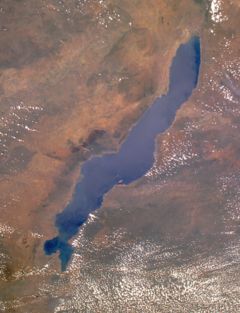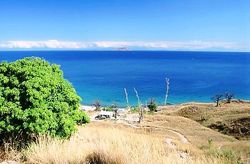Lake Malawi
2007 Schools Wikipedia Selection. Related subjects: African Geography
| Lake Malawi | |
|---|---|
|
|
|
| Coordinates | |
| Lake type | Rift Valley lakes |
| Primary sources | Ruhuhu |
| Primary outflows | Shire River |
| Basin countries | Mozambique Malawi Tanzania |
| Max-length | 560 km |
| Max-width | 75 km |
| Surface area | 29,600 km² |
| Average depth | 292m |
| Max-depth | 706m |
| Water volume | 8,400 km³ |
| Surface elevation | 500 m |
| Islands | Likoma Chizumulu |
| Settlements | Niassa, Mozambique Ruvuma, Tanzania |
Lake Malawi, also known as Lake Nyasa, Lake Nyassa, or Lake Niassa after the Yao word for "lake" (officially called Niassa in Mozambique), is the most southerly lake in the Great African Rift Valley system. Famously visited by the Scottish explorer and missionary Dr. David Livingstone, Lake Malawi has sometimes been referred by English-speaking people as "Livingstone's Lake."
Geography
The lake is about 560 km long and 75 km wide at its widest point, with a total area of approximately 29,600 km², and is bordered by Mozambique, Malawi, and Tanzania. Its outlet is the Shire River; its largest tributary is the Ruhuhu.
The lake lies in the Great African Rift Valley, a large graben caused by crustal extension. It probably formed about 40,000 years ago.
Borders on the lake
The larger part of the lake is in Malawi. The partition of the lake area between Malawi and Tanzania is disputed. Tanzania claims international borders through the lake like the colonial borders between the German and British teritories before 1914; Malawi claims the whole lake area including the waters next to the Tanzanian shore. This is based on the British administration after 1919 which put the whole lake under British Nyasaland for obvious practical reasons without a separate administration for the Tanganyika portion. The dispute has led to conflicts in the past. For the time being the conflict is dormant and Malawi has not been trying for years to enforce it claims to the Tanzanian part of the lake area. About a quarter of the lake area is in Mozambique, this includes the area surrounding the islands of Likoma and Chizumulu.
European discovery and colonization
David Livingstone was the first European to discover the lake, in 1859. Much of the area surrounding the lake was subsequently claimed by the British Empire to form the colony of Nyasaland. Although Portugal colonised the eastern shores of the lake, the islands of Likoma and Chizumulu which lie just off the shore were colonised by Scottish missionaries from Nyasaland, and as a result were incorporated as part of Nyasaland rather than Mozambique. Today they form lacustrine enclaves: Malawi territory surrounded by Mozambique waters.
In 1914, the lake saw a brief naval engagement when a British ship, on hearing that World War I had begun, sank a German ship in Deutsch Ost-Afrika (see History of Tanzania) territorial waters.
Important islands
There are two inhabited islands in the lake, Likoma and Chizumulu. Although the islands belong to Malawi, they are completely surrounded by Mozambique territorial waters. Likoma is dominated by a huge stone Anglican cathedral, built by missionaries in the early 20th century. A notable feature of both islands is the large number of Baobab trees. The islands support a population of several thousand people, who grow cassava, bananas and mangos, as well as fishing the waters of the lake.
Lake transport
Large-scale transport between settlements along the shores of the lake and between the Malawi shore and Likoma and Chizumulu islands is provided by steamers. The MV Ilala is the best known, although in recent years has often been out of service. When running, it travels between Monkey Bay at the southern end of the lake to Karonga in the north, and occasionally to Iringa Region in Tanzania.
Boats travel about twice a week from Nkhata Bay on the mainland to Likoma and Chizumulu islands, taking about five hours to cross the lake. Neither island has a usable port, and boats moor offshore before transferring passengers and produce to the shore in small dinghies.
Informal transport between the two islands, and between Likoma Island and the Mozambique town of Cobue, is provided by small dhow-type boats.
Wildlife
Lake Malawi has traditionally provided a major food source to the residents of Malawi as it is rich in fish, the most famous of which are the Chambo, consisting of anyone of 4 species of the cichlid genus Nyasalapia, as well as the Kampango, a large catfish (Bagrus meridionalis). Lake Malawi is famous for its cichlids, popular in the aquarium trade. Malawi cichlids are divided into two basic groups. These are loosely referred to as the Haplochromines and the Tilapiines. Within this first group (Haplochromines) are two sub-groups. The first sub-group consist of the open water and sand dwelling species with males usually sporting bright colors while the females show a silvery coloration with irregular black bars or various other markings. The second sub-group is known locally and popularly as mbuna, which means rockdweller. Mbuna are smaller, generally vegetarian, and both sexes are often quite colorful, though many species are dimorphic. The second group, the Tilapiines, consists of the only substrate spawning species in the lake (Tilapia rendalli), as well as the 4 species of Chambo (Nyasalapia). The genera Maylandia and Labidochromis are popular cichlids in the international aquarium scene. Cichlids are an important export for Malawi, but wild populations are increasingly threatened by overfishing and localized pollution. Other wildlife resident in the lake includes crocodiles, and a large population of fish eagles which feed off the fish population.
The lake also supports populations of snails some of which carry bilharzia. For many years this was strenuously denied by the government, which feared it would deter tourism in the area, but since the fall of Hastings Banda, the presence of bilharzia in the lake has been more widely acknowledged. (However, due to the overfishing of snail eating cichlids in the lake, this has caused what little bilharzia did exist to greatly increase to the point of being a hazard to bathers in the south east portion of the lake).
Water Chemistry
The water in lake Malawi is typically alkaline with a pH of 7.7 - 8.6, a carbonate hardness of 107 - 142 mg L-1 and a conductivity of 210-285 µS cm-1. The lake water is generally warm having a surface temperature that ranges from 24 - 29 ° C (75 - 84 ° F) and a deep level temperature of 22 °C (71.6 °F)

